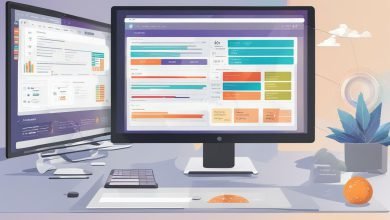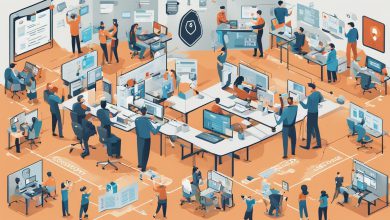
Welcome to the world of software development! Writing maintainable software is an art and a science that requires expertise in software engineering, software architecture, and software optimization. Writing clean code is an essential part of software development that contributes to software quality, enhances software usability, and ensures software longevity.
As a software developer, it is imperative to follow software best practices while writing code to ensure its longevity. Clean code is about writing readable code that is easy to understand, maintain, and optimize. It supports efficient teamwork, streamlined debugging, and faster deployment. In this article, we will delve deeper into Clean Code – the art and science of writing maintainable software. We will explore its benefits, best practices, and the role of software architecture in achieving it.
Key Takeaways:
- Clean Code is the art and science of writing maintainable software that supports software quality, usability, and longevity.
- Writing clean code requires following software best practices and writing readable code that can be easily maintained and optimized.
- Software architecture plays a crucial role in achieving clean code by providing a structure that supports readability, maintainability, and scalability.
Understanding Clean Code and Its Benefits
Writing maintainable software is essential for any software development project. Clean code is a set of software best practices that enhances the maintainability and readability of code. It is a software engineering approach that emphasizes code quality, software architecture, and software optimization.
Clean code is crucial in software development because it improves the code quality, making it easier to understand, debug, and modify. It enables software developers to write better code that is scalable and adaptable to future changes. Clean code produces software that is easier to maintain, which in turn reduces the time and resources required for maintenance and updates.
By following practices such as commenting code, using meaningful function and variable names, and breaking down complex code into smaller modules, writing maintainable software becomes more achievable. With clean code, software developers can improve their coding skills, enhance collaboration, and produce high-quality software.
Best Practices for Writing Maintainable Software
Writing maintainable code is one of the most important aspects of software development. Clean Code is the foundation for writing maintainable code. Clean Code is code that is easy to understand, modify, and maintain. Writing Clean Code requires following a set of best practices and principles that will improve the readability and quality of your code.
Readable Code
The first principle of Clean Code is readability. Code should be easy to read and understand. This is achieved by using descriptive names for variables, functions, and classes. Use meaningful comments to explain the code’s intent, rather than explaining what the code does. Long functions should be broken down into smaller functions, and each function should perform a single task.
Consistency
Developers should follow consistent coding conventions throughout the project. This includes naming conventions, formatting, and structure. Simple and consistent code is easier to read and understand, making it more maintainable.
Error Handling
Effective error handling is important for writing maintainable code. Errors should be handled consistently and gracefully, with clear error messages that indicate what went wrong and how to fix it. This helps to identify and fix bugs quickly.
Testing
Testing is an important part of writing maintainable code. Testing ensures that the code works as intended and can help catch errors early on. When writing tests, it is important to test all possible scenarios and edge cases.
By following these best practices, you can improve the readability and quality of your code, making it easier to maintain and modify over time.
The Role of Software Architecture in Clean Code
Software architecture plays a crucial role in developing clean code that is maintainable and of high quality. A well-designed architecture enables developers to easily make changes and improvements, keeping the code clean and functional.
One key aspect of software architecture is its ability to provide a clear structure for the codebase. This includes organizing the code into modules and layers, establishing clear boundaries and interfaces, and ensuring that each component has a well-defined purpose.
Another important aspect is the use of design patterns. These proven solutions enable developers to address common problems in a consistent and efficient way, reducing the risk of creating messy or convoluted code.
The Benefits of a Strong Architecture
A strong software architecture provides a range of benefits that contribute to the maintainability and quality of the codebase. For example, it:
- Enables developers to easily identify and fix issues
- Reduces the likelihood of regressions and errors
- Facilitates collaboration and communication among team members
- Enables better scalability and extensibility
Overall, a strong software architecture is an essential component of writing maintainable and high-quality code that will stand the test of time.
Clean Code: The Key to Writing Maintainable Software
If you’re a software developer, you know that writing maintainable code is crucial for the success of any software project. Clean Code is the art and science of writing readable, understandable, and maintainable code. Let’s take a closer look at how Clean Code can help you optimize your software development process.
What is Clean Code and its Benefits?
Clean Code is a software development practice that emphasizes the importance of writing code that is easy to understand, modify, and maintain. Clean Code helps you to optimize the software development process, reduce the cost of development, and improve the quality of your code. It makes your codebase more readable, understandable, and maintainable.
Software projects can become complex and difficult to maintain over time. Clean Code helps you to keep your codebase manageable and easy to work with, even as the project grows in size and complexity. It helps you to detect and fix bugs more easily, and to add new features to your codebase without introducing new bugs or breaking existing functionality.
Best Practices for Writing Maintainable Software
Writing maintainable code requires adherence to best practices. Some best practices include: writing code that is easy to read and understand, avoiding code duplication, writing unit tests, and using software design patterns.
One of the most important best practices for writing maintainable code is to write code that is clean and readable. This means writing code that is easy to understand, with clear and descriptive naming conventions, and avoiding overly complex logic.
Another best practice is to write unit tests for your code. Unit tests are small tests that verify the behavior of individual functions or code sections. They help you to detect and fix bugs more easily, and to ensure that your code is functioning correctly.
Using software design patterns is also a best practice for writing maintainable code. Design patterns are reusable solutions to common software development problems. They help you to write code that is more modular, flexible, and easy to maintain over time.
The Role of Software Architecture in Clean Code
Software architecture plays a crucial role in writing clean code. A good software architecture helps you to write code that is modular, flexible, and easy to modify and maintain. It helps you to separate concerns, so that each component of your application has a clear and well-defined purpose.
When designing your software architecture, it’s important to consider scalability, performance, and maintainability. Your architecture should be designed to handle the needs of your application as it grows in size and complexity over time. It should also be designed for performance and optimized for speed.
Conclusion
In conclusion, Clean Code is the key to writing maintainable software. Following best practices for writing clean and readable code, using software design patterns, and considering software architecture are all important elements of the Clean Code practice. By using Clean Code, you can optimize your software development process, reduce the cost of development, and improve the quality of your codebase.
FAQ
Q: What is clean code?
A: Clean code refers to well-structured, readable, and maintainable code that follows best practices in software development. It emphasizes writing code that is easy to understand, modify, and debug.
Q: Why is clean code important?
A: Clean code is important because it improves the overall quality of software. It makes it easier for developers to collaborate, reduces bugs and errors, and enhances the maintainability and scalability of the software.
Q: How can I write clean code?
A: Writing clean code involves following best practices such as using meaningful variable and function names, keeping functions and classes small, reducing code duplication, and properly commenting and documenting the code.
Q: Does clean code affect software performance?
A: While clean code primarily focuses on readability and maintainability, it can indirectly improve software performance. By optimizing code and reducing complexity, clean code can lead to better performance and faster execution times.
Q: Can clean code be applied to any programming language?
A: Yes, the principles of clean code are applicable to any programming language. While the specific syntax may vary between languages, the core concepts of readability, maintainability, and best practices remain consistent.








